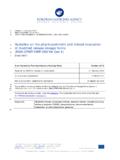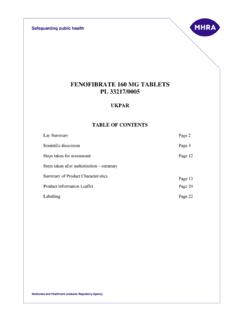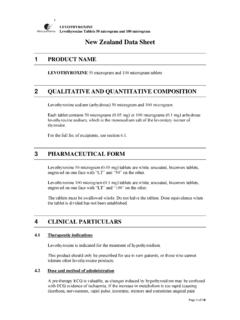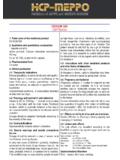Transcription of DEVELOPMENT OF PAEDIATRIC MEDICINES: …
1 UNEDITED DRAFT ANNEX TO 46TH REPORT OF THE WHO EXPERT COMMITTEE ON SPECIFICATIONS FOR PHARMACETICAL PREPARATIONS DEVELOPMENT OF PAEDIATRIC MEDICINES: POINTS TO CONSIDER IN FORMULATION BACKGROUND At the forty-second meeting of the WHO Expert Committee on Specifications for Pharmaceutical Preparations held on 15-19 October 2007, a draft on DEVELOPMENT of PAEDIATRIC Medicines: Points to Consider (update of the version dated 14 May 2007) was discussed with a view to contributing to the pharmaceutical part of the document. This document was prepared by Professor Kristensen, Denmark and presented a first draft on pharmaceutical DEVELOPMENT of PAEDIATRIC medicines. It was based on the above-mentioned paper and the European Medicines Agency (EMA) Reflection Paper: Formulations of Choice for the PAEDIATRIC population (2006). An extended revision on pharmaceutical DEVELOPMENT as a stand-alone text was drafted in February 2008 (working document ).
2 Upon circulation of this document a great number of comments were received. Valuable comments on the pharmaceutical DEVELOPMENT of PAEDIATRIC medicines were given, but they also showed that the draft gave too much emphasis on general issues of the DEVELOPMENT of generic medicines. A WHO consultation on paediatrics and generics draft guidelines was held in April 2010, resulting in a revision of the guidance on draft pharmaceutical DEVELOPMENT for multisource (generic) pharmaceutical products ( ) circulated for comments in June 2010; the first draft was mailed out for comments in June 2008 An outline of the PAEDIATRIC guidance was discussed at the April 2010 consultation. Another version of the working document was prepared, based on the discussions during that meeting, the feedback and comments received - 2 - on the previous version, and the report of the WHO Informal Meeting on Dosage Forms of Medicines for Children, December 2008.
3 Upon wide recirculation comments were received. This feedback was discussed preliminarily during the Expert Committee meeting in October 2010. A new revision was prepared by Professor Kristensen, taking new trends and DEVELOPMENT , such as the current efforts undertaken by regulatory authorities, into account. The new proposal was then discussed during an informal consultation held in May 2011. The outcome of that meeting has again been distributed for comments. General note The points to consider document should not detail instructions for DEVELOPMENT but should rather make reference to relevant literature. Some matters dealt with in the draft on DEVELOPMENT of multisource products have, therefore, been omitted in this proposal. Contents page 1. Introduction .. 2. PAEDIATRIC dosage forms .. Convenient, reliable administration .. Acceptability and palatability .. Minimum dosing frequency.
4 End-user needs .. 3. Dosage forms to be considered in particular .. 4. Formulation design .. Quality .. Biopharmaceutics classification Excipients .. Colouring agents .. Antimicrobial preservatives .. Sweetening agents .. Taste masking .. - 3 - Solubility enhancers .. 5. Oral administration .. Oral liquid preparations .. Administration through feeding tubes .. Oral solid dosage forms .. 6. Rectal administration .. Suppositories .. Rectal liquids (enemas) .. 7. Parenteral administration .. 8. Dermal and transdermal administration .. Transdermal patches .. 9. Inhalations .. 10. Packaging and 11. Glossary .. 12.. 1. INTRODUCTION Safe and effective pharmacotherapy in PAEDIATRIC patients requires the timely DEVELOPMENT of medicines and information on their proper use that suit the age, physiological condition and body sizes of the child.
5 Formulations developed specifically for children are often needed. The use of unlicensed and off-label medicines in children is widespread. Their effects on children have not been properly studied, age-appropriate formulations are generally not available, and they are not licensed for use in children. Pharmacists, parents or caregivers are often faced with the need to manipulate an adult medicine in a way that is not described in the Summary of product characteristics. This can be rather simple, breaking tablets that do not have a score line with a tablet splitter, or complex, using tablets as a source for an active pharmaceutical ingredient (API) to prepare a suspension. Pharmacists may also be faced with the need to compound a medicine on the basis of the API. - 4 - This process itself can increase the potential for dosage accuracy errors and in general can increase the variability of the product.
6 Such handling may be potentially hazardous for the patient as it may affect the stability, bioavailability and accuracy of dosing of a finished pharmaceutical product (FPP), in particular for controlled-release preparations. The use of such medicines may expose children to overdosing and unintended side-effects or underdosing without the expected efficacy. Moreover, excipients that are safe for adults may not necessarily be so for children. In December 2007 WHO launched its initiative Make medicines child size in order to raise awareness of and accelerate action for the need for improved availability and access to child-specific medicines. The WHO Model Formulary for Children, 2010, provides independent prescriber information on dosage and treatment guidance for medicines based on the WHO Model List of Essential Medicines for Children, first developed in 2007 and reviewed and updated every two years.
7 Among actions to support the Make medicines child size initiative is the present Points to consider document on the formulation of PAEDIATRIC medicines. The scope is to inform regulatory authorities and manufacturers on issues that require special attention in pharmaceutical formulation. Focus is on the conditions and needs in developing countries. The guidance does not provide exhaustive information and does not preclude other aspects relevant to the DEVELOPMENT of PAEDIATRIC medicines. It is not the scope of this document to address extemporaneous preparations and compounding. A separate interim guidance document entitled "Provision by health-care specialists of patient-specific preparations that are not available as authorized products points to consider" (working document ) will supplement and deal with such preparations. 2. PAEDIATRIC DOSAGE FORMS The PAEDIATRIC population is a heterogeneous group ranging from newborns to adolescents with large physical and developmental differences regarding pharmacokinetics and pharmacodynamics.
8 Organ maturation, metabolic capacity, skin maturation and other factors may change with age, especially in early infancy ( ). The age groups identified by ICH - 5 - ( ) have been derived mainly from physiological and pharmacokinetic differences from birth to adult: preterm newborn infants; term newborn infants (0 27 days); infants and toddlers (28 days 23 months); children (2 1 years); and adolescents (12 to 16 18 years (dependent on region)). It is a challenge to find one formulation appropriate for all age groups. The aim should be to safely cover as wide an age range as possible with a single formulation. The guiding principle for selecting PAEDIATRIC dosage forms should be as for adults the balance of risk/benefit ( ) taking into account the specific needs of this vulnerable population. During the DEVELOPMENT of pharmaceutical products, the assessment of individual risks related to specific products and starting materials and the recognition of hazards at specific stages of production or distribution, will enable to further enhance the usual quality assurance mechanisms, such as implementation of good manufacturing practices (GMP), by increasing the effectiveness of the activities of all parties involved within the limits of the available resources.
9 Manufacturers who have chosen a more systematic approach to product DEVELOPMENT would follow the DEVELOPMENT within the broader context of quality assurance principles, including the use of quality risk management and pharmaceutical quality systems. (Ref.: Quality risk management ( ) and Pharmaceutical DEVELOPMENT of multisource (generic) finished pharmaceutical products - points to consider, ( ). Current use of medicines for the PAEDIATRIC population reflects the full range of dosage forms and routes of administration used for adult medicines. Common routes of administration in PAEDIATRIC patients include oral, parenteral, dermal, pulmonary, nasal, rectal and ocular uses. There is, however, limited information on the acceptability of different PAEDIATRIC dosage forms in relation to age and therapeutic needs, nor is there sufficient knowledge on the safety of excipients in relation to the DEVELOPMENT of the child. A European Medicines Agency (EMA) Reflection Paper on PAEDIATRIC formulations ( ) provides background information on these issues.)
10 Reviews by Ernest et al ( ) and Krause J and Breitkreutz J ( ) discuss the needs and challenges in developing PAEDIATRIC medicines. - 6 - Desirable features of quality PAEDIATRIC medicines common to all dosage forms are outlined below. Further information on specific dosage forms is given in the following chapters. Convenient, reliable administration The administered dose should contain an amount of API adjusted to the age and needs of the child. The implication is that more than one dosage form of the API or more than one strength of a dosage form may be needed to cover different age groups. The intended dose volume or size should be appropriate for the target age group. PAEDIATRIC medicines should preferably be presented as formulations that are ready to administer. The need to manipulate the dose by health professionals, parents or caregivers prior to administration should be kept to a minimum. However, there might be situations, depending on the formulation properties and the dose range to be covered, where this cannot be avoided.















